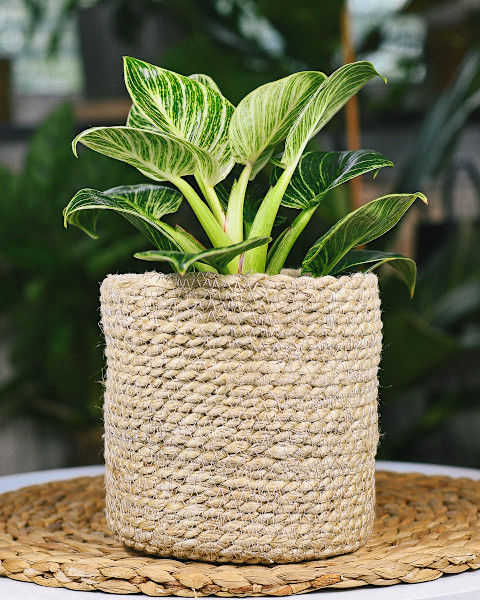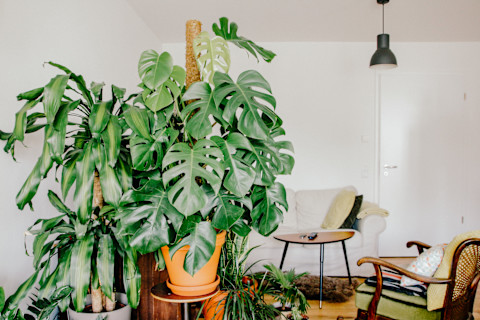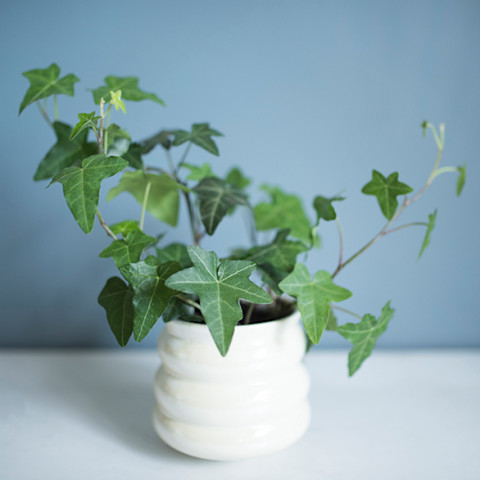Climbing houseplants can bring the cottagecore aesthetic of warmth into any home or apartment. They make wonderful additions to bookshelves, ledges, showers, and anywhere else you feel could look better with a touch of green. Opting for houseplants that climb can also free up valuable floor and counter space, which makes them particularly great for small spaces.
Here are 15 bold and beautiful plants that can climb indoors wherever you place them without much effort.
How to keep climbing plants indoors (and help them grow faster).
Climbing houseplants, or vining plants, are fit for any level of plant parent. If you're in the market to add a climbing plant to your home, coordinating the type of plant with the space you'd like it to take up is a great place to start.
"I recommend working backward from where you want your plants to end up, [taking] into account how much light that space will receive," Ellise Uyema, CEO of plant-centered lifestyle brand Live Long and Plant, tells mindbodygreen. Here are a few other tips to help your climbing plant thrive indoors:
Give them something to climb.
If you'd rather have your plant climb up something than hang down from it, you'll need to give it some guidance.
"Moss poles are a great way to train a plant to climb," says Uyema. You can stick the moss pole straight into your plant's soil. Then, use some twine or garden wire to secure sections of the stem to the pole, adjusting their location over time.
You can also perch your plant next to existing structures such as arches, doorways, bookshelves, and headboards.
When there's a particular shape you'd like your plant to follow, command hooks or clips are an efficient (and less destructive) way to support and guide the vines. Trellises will also support the vertical growth of a plant, and they come in various shapes, sizes, and materials.
Water as normal.
As with any indoor houseplants, you'll want to make sure your climbing plant is set up in a well-draining planter. You'll want to do your research on the particular plant(s) you have to see how much water they need, but these watering tips offer some good general guidance.
For the plant parents who value convenience or tend to forget watering schedules, Uyema suggests investing in a self-watering planter. And for those high, hard-to-reach plants with a mind of their own, a watering can with a long spout may not be a bad idea.
Give it plenty of light (and an occasional trim) for faster growth.
When plants reach for a light source, they tend to get leggy (meaning they have large areas of exposed stems without any leaves). This is very common with hanging plants. To keep your plant looking lush and help it grow faster, be sure to give it enough sunlight. Fertilizers can also promote growth. Trimming your plant back from time to time—Uyema recommends about twice a year—will encourage new leaves, too.
The best climbing plants for indoors.
1. String of Hearts (Ceropegia woodii)
The String of Hearts is a semi-succulent native to South Africa. This stunner thrives in bright, indirect sunlight, preferably away from drafts, and well-draining soil. In the right conditions, you might even catch this beauty bloom.
As far as watering goes, treat the string of hearts like a succulent, letting the soil dry in its planter completely at least two-thirds of the way (use your finger to check!).
Growth rate: Fast

2. Golden Pothos (Epipremnum aureum)
One of many varieties of pothos, the Golden Pothos can be picked out from a lineup by its characteristic heart-shaped yellow and green leaves. It's an adaptable plant that can grow in the most unlikely spaces (think basements) but prefers the warmth of the sun to maintain its coloration.
Give your pothos ample time between waterings, allowing the top half of the soil to get bone dry.
Growth rate: Fast

3. Philodendron (Philodendron)
This common houseplant (450 species and counting!) is low maintenance and can do spectacularly in the same soil for two to three years. Native to the tropics, Philodendron thrives in bright to medium indirect light but can tolerate bouts of shade.
As far as watering goes, it prefers room-temperature water whenever the first inch or two of the soil is dry to the touch.
Growth rate: Medium

4. Spider Plant (Chlorophytum comosum)
Native to the coast of West and South Africa, the funky Spider Plant can be quite tolerant of its environment yet temperamental when faced with sudden changes to it. As a coastal plant, it enjoys moderate to bright indirect light and humidity. In addition to watering when the top few inches of the soil is dry, a light misting every once in a while will keep it happy.
This plant is incredibly sensitive to overwatering, so it requires a bit more attention to prevent root rot. To help the soil drain, you can throw in perlite or coconut coir for good measure.
Growth rate: Fast

5. Swiss Cheese Plant (Monstera)
The Swiss Cheese Plant is a natural-born climber that thrives in indirect sunlight and well-draining potting mix. In the right conditions, it can grow as tall as 8 feet with voluptuous leaves.
Depending on where you live, you'll want to give yours a drink do so every seven to 10 days when it's warm and every 12 to 20 days when it's cold.
Growth rate: Medium

6. Maidenhair Fern (Adiantum)
More on the finicky side, the Maidenhair Fern has delicate leaves that add a softness to your home. Found in forests across the Northeast U.S. to the Andes mountains, these plants like it wet, humid, and misty.
Because these conditions are hard to recreate at home, the fern is considered high maintenance. Put it near an east- or north-facing window in a nice plastic pot with well-draining soil and water anytime the top of the soil is even slightly dry—usually once or twice a week.
Growth rate: Slow

7. String of Pearls (Senecio rowleyanus)
String of Pearls is a low-maintenance succulent that thrives in well-draining soil with a little perlite or sand. The pearls on this plant are meant to store water, making it incredibly drought-tolerant. You can water it intensely one week and completely ignore it the next.
It enjoys a combination of direct and indirect bright sunlight. Stick it near a window that can be diffused with a sheer curtain for a few hours a day to keep it happy.
Growth rate: Fast

8. Hoya Krimson Queen (Hoya Variegata)
One of many hoya varieties, Hoya Krimson Queen thrives in constant bright, indirect sunlight and humidity. This may mean installing some kind of artificial growth light for the darker times and months and placing it near other plants or investing in a humidifier to mock its native rain-forest climate. As far as watering goes, this queen likes a drink one to three times a week.
Growth rate: Slow

9. Small-Leaf Spiderwort (Tradescantia fluminensis variegata)
Native to South America, the small-leaf spiderwort is an easy-to-care-for plant that enjoys bright, indirect sunlight and a well-draining potting mix. Susceptible to overgrowth, this vining plant may require more frequent trimmings to keep it in check. It's an easy enough plant to keep quenched so long as it receives frequent waterings to keep the soil moist but not soggy.
Growth rate: Medium

10. String of Turtles (Peperomia Prostrata)
The string of turtles is a succulent with small leaves that resemble—you guessed it—turtle shells. They make charming additions to a bookshelf or anywhere in your home that receives mostly indirect sunlight and a good chunk of direct sunlight a day. As a succulent, they can thrive with a good watering whenever half to three-fourths of the soil is dry to the touch.
Growth rate: Slow

11. English Ivy (Hedera helix)
English Ivy thrives in precise conditions: bright light, fluorescent light if placed in a shady area, and in a planter with slightly acidic, well-draining soil. It's a major climber that enjoys staying on the drier side. Water it once a week or when the top of the soil is dry to the touch but not crumbly dry.
Growth rate: Medium

12. Jasmine (Jasminum polyanthum)
Jasmine plants are known for their wonderful aroma. This particular variety is commonly grown indoors and is an industrial climber. With the right combination of sunlight, cool temperatures, and good airflow, jasmine thrives and can even flower. It enjoys good watering multiple times per week to keep the soil moist but not drenched. Given how quickly it grows, a trellis offers prime support for this plant.
Growth rate: Fast

13. Mistletoe Cactus (Rhipsalis baccifera)
Mistletoe cactus is a succulent that puts out flowers and inedible berries in the right conditions. It grows best in medium to low light in well-draining soil. The plant's watering needs depend on the time of year: In the spring and summer, water whenever the surface of the soil gets dry, misting every once in a while. In the autumn and winter, wait to water until the first few inches of soil are dry.
Growth rate: Slow

14. Creeping Fig (Ficus pumila)
Cousin to the Fiddle Leaf Fig, the creeping fig is a smaller variety that bears fuzzy pear-shaped fruit in its prime. Place it in a room with medium to bright indirect light, and surround it with your other houseplants to give it the humidity it loves. You'll know it's thirsty when its top inch of soil is dry, which will happen about once a week.
Growth rate: Fast

15. Kangaroo Vine (Cissus antarctica)
The Kangaroo Vine is a low-maintenance perennial native to the coast of Australia that bears golden flowers and edible berries in the right conditions. (Though, when grown indoors, you may not get to witness it bloom.)
It's perfectly happy with a range of sunlight so long as it isn't direct, frequent watering, and an adequate level of humidity.
Growth rate: Fast

FAQ
What climbing plant grows fastest?
Pothos is the climbing plant that grows fastest, growing up to 12 inches in a month under the right conditions! While there are other fast-growing plants on this list, none compare to the growth rate of a pothos.
What climbing plants can survive in low light?
Mistletoe Cacti and Pothos can both survive in lower light conditions. Philodendron can tolerate bouts of shade too but much prefers a higher dose of sunlight.
The takeaway.
Climbing plants make wonderful additions to your home. They bring a piece of the wild outdoors inside without taking up too much space and have the same care needs as your standard houseplant. With a little creativity, there's a lush plant for just about any ceiling, piece of furniture, or shelf you can imagine.
